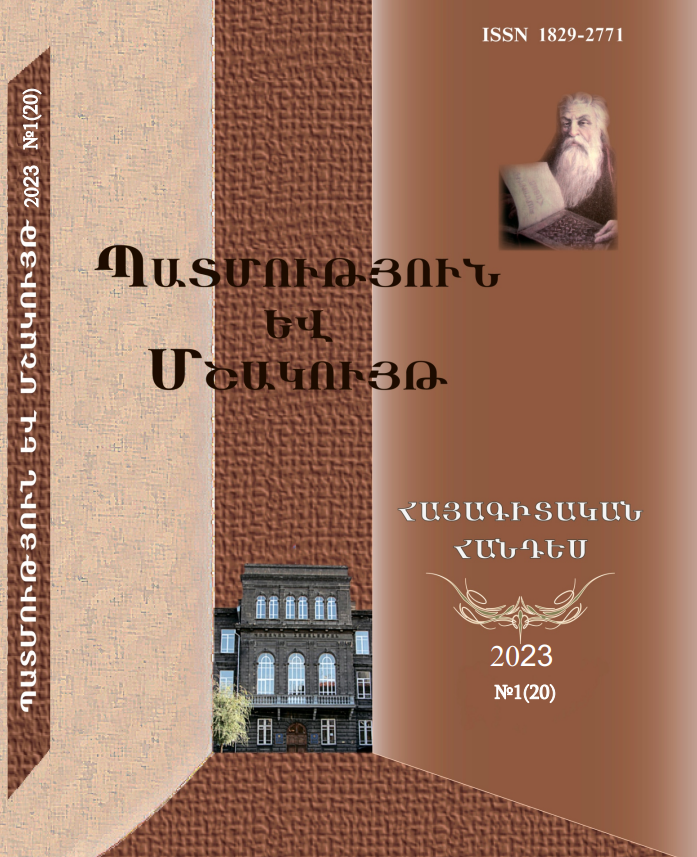The Mkhitaryan Congregants on the Croatian National Struggle in 1848-1849
DOI:
https://doi.org/10.46991/hc.2023.20․2․048Keywords:
Austrian Empire, Croatia, illirism, national struggle, autonomy, Jelacic, ’’Europe’’, ‘’Bazmavep’’Abstract
The revolutionary and national-liberation movements that broke out in the Austrian Empire found a wide response in the Armenian public mind of the time and in the periodical press. The members of the Mkhitaryan Congregation in Venice and Vienna, as well as ‘’Europe’’ and ‘’Bazmavep’’ periodicals, touched upon those movements and the national struggle of the Croats.
Historian Ghukas Inchichyan from the Mhitaryan Congregation in Venice, noticed that the Croats didn’t have an independent kingdom and were under foreign rule because of their disunity and cleavage. In his opinion, despite the fact that the Croats were brave, courageous people and good soldiers, they were revengeful and rancorous inside, which prevented them from coming together, uniting and struggling for independence.
Commenting on the temporary liberation of the Venetians from the Austrian rule, the editor of ‘’Bazmavep’’, Gabriel Archimandrite Aivazovsky noted with regret that their enjoyment was short-lived, for the Croatian soldiers mercilessly suppressed their movement and shed-blood.
The Mhitaryan congregants Ambrosios Archimandrite Galfayan and Grigor Archimandrite Govrikyan impartially and briefly presented the national movement of the Croats. The political weekly ‘’Europe’’ of the Vienna Mkhitaryans and Ghevond Archimandrite Hovnanyan elucidated that event more thoroughly. The editors of ‘’Europe’’ were obliged to present the political events in an impartial manner, to be faithful to the reliability of the received news. While generally mentioning that position in relation to the political events taking place in Europe, the Mkhitaryans in Vienna didn’t show the same approach when elucidating the struggle of the subject peoples of the Austrian Empire. They didn’t encourage the liberation struggle of the Hungarians against the Empire, but perceived the fact that the Croats’ struggle was entirely against the Hungarian government. According to the Mkhitaryans, the Croats, who stood up for their national autonomy, were loyal subjects of the Empire, were satisfied and happy with the constitution adopted by Frantz Joseph and thus ready to die for the Emperor.
References
References
Galemqyarean G. (1893), Patmutiyun hay lragrutean, Vienna, Mkhitaryan tparan, 226 ej: (in Armenian)
Galfayean A. (1851), Hamarotutiyn dzamanakakic patmutean, Venetik, tparan surb Khazar, 237 ej: (in Armenian)
Govrikean G. (1879), Yndhanur patmutiyn hamarot, Vienna, Mkhitaryan tparan, 300 ej: (in Armenian)
Inchichean X. (1815), Azgaser, Venetik, tparan surb Khazar, 226 ej: (in Armenian)
Karinyan A. (1960), Aknarkner hay parberakan mamuli patmutyan, h. 2, Erevan, Haykakan SSR GA hratarakchutyun, 635 ej: (in Armenian)
Hovnanean H. (1860), Xevond v., Patmutyun qaxaqakanutyan evropakan teruteanc yndhanrapes, h. D, Vienna, Mkhitaryan tparan, 445 ej: (in Armenian)
«Arshaluys araratyan», 1849, 24 hunisi, № 340: (in Armenian)
«Bazmavep», 1843, hator arajin, ej 3-4: (in Armenian)
«Bazmavep», 1848, 1 mayisi, № 9: (in Armenian)
«Bazmavep», 1851, 15 marti, № 6: (in Armenian)
«Evropa», 1848, 7 marti, № 10; 9 marti, № 19; 28 marti, № 13; 4 aprili, № 14; 25 aprili, № 17; 2 mayisi, № 18; 16 mayisi, № 20; 23 mayisi, № 121; 30 mayisi, №122; 20 hunisi, № 25; 27 hunisi, № 26; 25 hulisi, № 30; 19 septemberi, № 38; 3 hoktemberi, № 40; 9 hoktemberi, № 41; 17 hoktemberi, № 42; 7 noyemberi, № 45; 5 dektemberi, № 49, 12 dektemberi, № 50: (in Armenian)
«Evropa», 1849, 15 mayisi, № 20; 10 aprili, № 15; 5 hunisi, № 23; 12 hunisi, № 24; 26 hunisi, № 26; 7 ogostosi, № 32; 28 ogostosi, № 35; 11 septemberi, № 37: (in Armenian)
«Hayastan», 1848, 5 hunisi: (in Armenian)
Averbux R. A. (1965), Revoluciya i nacionalno-osvoboditelnaya borba v Vengrii 1848-1849 gg. Moskva, Nauka, 406 s. (in Russian)
Istoriya XIX veka (1938), t. 5. Pod red. Lavissa i Rambo, Moskva, Gosudarstvennoe socialno-ekonomicheskoe izdanie, 411 s. (in Russian)
Istoriya Vengrii (1972), tom II․ Pod red. M. Islamova, Moskva, Nauka, 607 s. (in Russian)
Istoriya Yugoslavii (1963), t. 1. Red. kol. Y.V.Bromley i drugie, Moskva, Izdatelstvo AN SSSR, 736 s. (in Russian)
Istoriya yuzhnikh i zapadnikh slavyan. (1969), Red. kol. I. M. Belyavskaya i drugie, Moskva, Izdatelstvo Moskovskogo universiteta, 536 s. (in Russian)
Osvoboditelnie dvizheniya narodov Avstriyskoy imperii. Vozniknovenie i razvitie. Konec XVIII v.-1849g. (1980), Red. kol. V. A. Dyakonov i drugie, Moskva, Nauka, 610 s. (in Russian)
Prister E. (1952) Kratkaya istoriya Avstrii, Moskva, Izdatelstvo inostrannoy literatury, 736 s. (in Russian)
Freydzon V. I. (2001) Istoriya Xorvatii. Kratkiy ocherk s drevneiskix vremen do obrazovaniya respubliki (1991g.), Sankt-Peterburg, Aleteiya, 318 s. (in Russian)
Downloads
Published
Issue
Section
License
Copyright (c) 2023 Feliqs Movsisyan

This work is licensed under a Creative Commons Attribution-NonCommercial-ShareAlike 4.0 International License.

